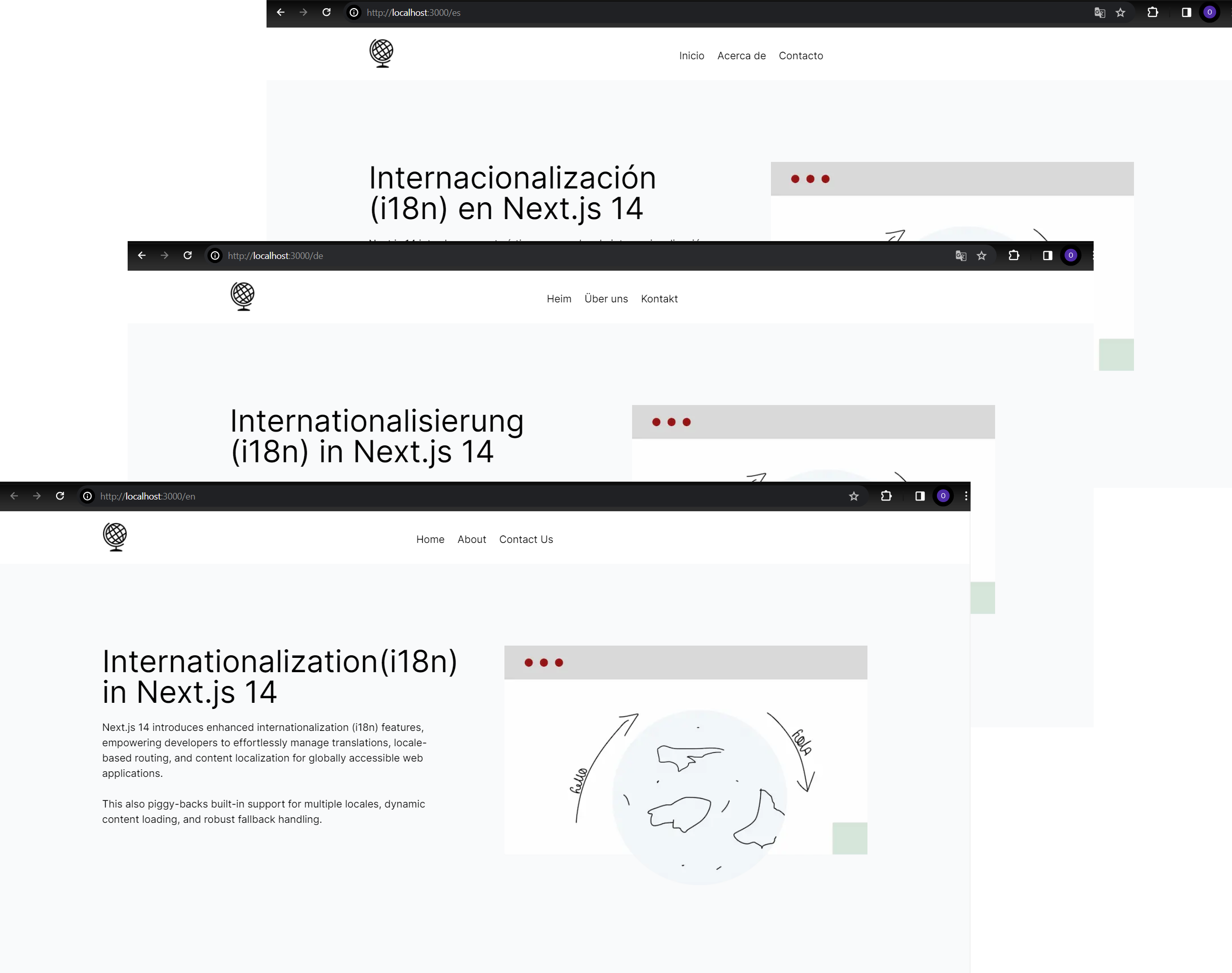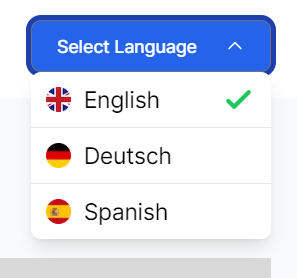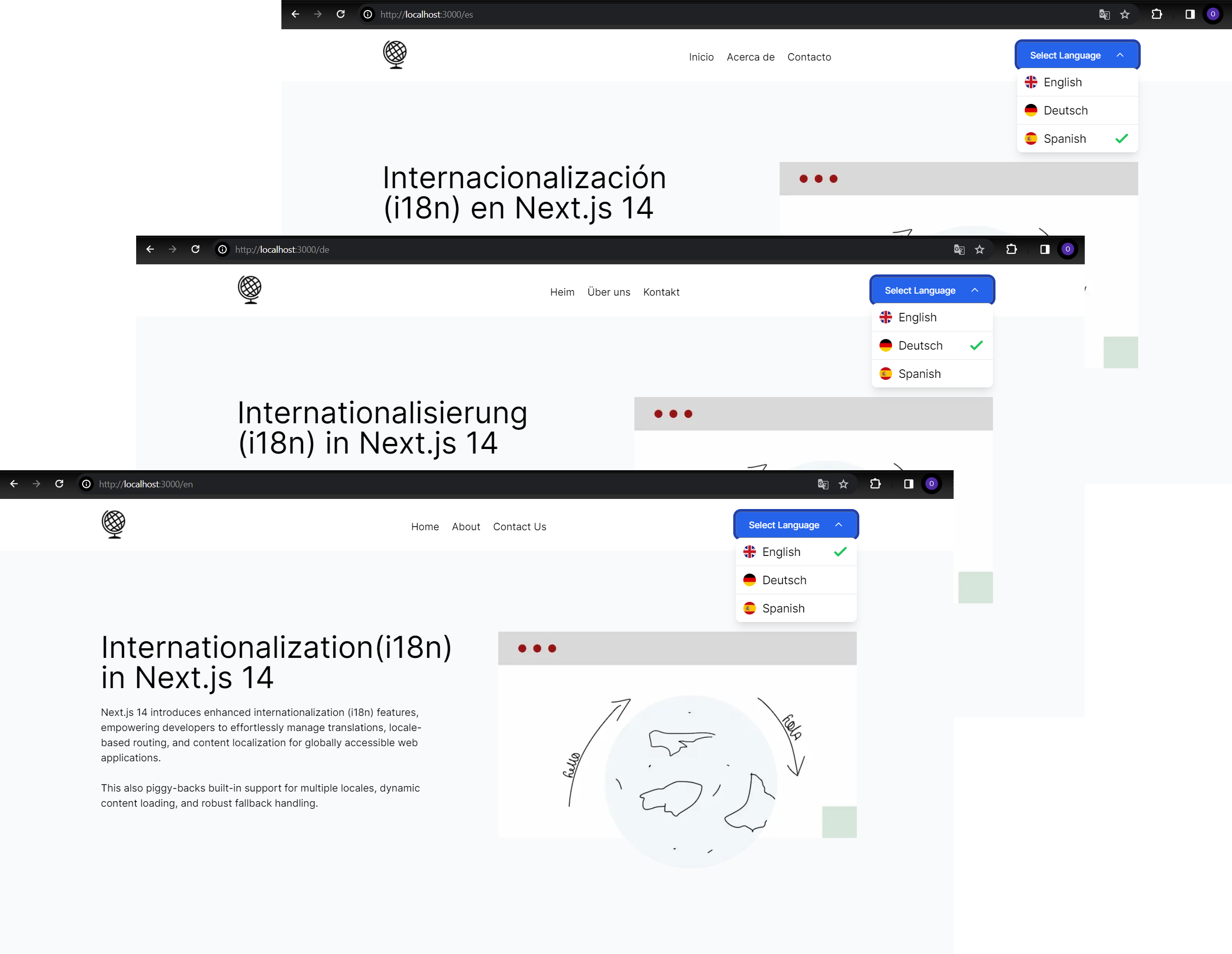On this article, we’ll dive into why internationalization (i18n) is essential for net improvement, discover Subsequent.js 14’s new options, and discover ways to construct multilingual net experiences effortlessly.
Think about touchdown on an internet site the place it is advisable extract a bit of essential info and all of the sudden hitting a language barrier. Irritating, proper? That’s the place internationalization (i18n) is available in, making web sites accessible to individuals worldwide.
Subsequent.js 14 simplifies multilingual net improvement with instruments like language routing and dynamic message loading. It’s designed to assist builders simply create dynamic, multilingual net apps.
By the conclusion of this text, we’ll have sensible insights into internationalization in Subsequent.js 14, from establishing a brand new challenge to including language switching.
Setting Up a Subsequent.js 14 Venture
Let’s begin by establishing our challenge with built-in i18n.
Step 1. Create a recent Subsequent.js challenge by operating the command beneath. For the sake of this text, we’ll title it i18n-next-app:
npx create-next-app i18n-next-app
Step 2. Navigate into your challenge folder and set up Subsequent.js (Model 14) and the next-intl bundle:
cd i18n-next-app
npm set up subsequent@newest next-intl
The command above installs Subsequent.js together with its most up-to-date options, similar to i18n, and consists of next-intl. The rationale behind using next-intl is its seamless integration with the App Router by way of a [locale] dynamic phase. This integration permits us to ship content material in numerous languages.
Step 3. Allow i18n help in Subsequent.js 14 in your challenge by including the next configuration in your subsequent.config.js:
const withNextIntl = require('next-intl/plugin')();
module.exports = withNextIntl({
});
This code above configures Subsequent.js with the next-intl plugin for enhanced internationalization capabilities. It imports the plugin and applies it to the Subsequent.js configuration, permitting builders to simply incorporate internationalization options into their initiatives. That is achieved whereas giving room to protect different challenge configurations.
Step 4: Create a content material folder on the challenge’s root. Inside, create JSON information for every locale (en.json, es.json, de.json), containing your translated strings. This method compensates for Subsequent.js’s present limitation in automated translation.
For the sake of this challenge, we’re going to make use of English, Spanish, and German, however be at liberty so as to add extra locales as wanted to your challenge’s necessities:
{
"Residence": {
"navigation": {
"dwelling": "Heim",
"about": "Über uns",
"contact": "Kontakt"
},
"title": "Internationalisierung (i18n) in Subsequent.js 14",
"description": "Subsequent.js 14 führt erweiterte Internationalisierungs (i18n)-Funktionen ein, die Entwicklern ermöglichen, Übersetzungen, lokalisierungsbasiertes Routing und Inhaltslokalisierung für weltweit zugängliche Webanwendungen mühelos zu verwalten. <br /> <br />Darüber hinaus bietet es integrierte Unterstützung für mehrere Sprachvarianten, dynamisches Inhaltsladen und robuste Fallback-Behandlung."
}
}
{
"Residence": {
"navigation": {
"dwelling": "Inicio",
"about": "Acerca de",
"contact": "Contacto"
},
"title": "Internacionalización (i18n) en Subsequent.js 14",
"description": "Subsequent.js 14 introduce características avanzadas de internacionalización (i18n), capacitando a los desarrolladores para gestionar fácilmente traducciones, enrutamiento basado en localización y localización de contenido para aplicaciones net globalmente accesibles. <br /> <br />Esto también aprovecha el soporte incorporado para múltiples locales, carga dinámica de contenido y manejo de respaldo robusto."
}
}
{
"Residence": {
"navigation": {
"dwelling": "Residence",
"about": "About",
"contact": "Contact Us"
},
"title": "Internationalization(i18n) in Subsequent.js 14",
"description": "Subsequent.js 14 introduces enhanced internationalization (i18n) options, empowering builders to effortlessly handle translations, locale-based routing, and content material localization for globally accessible net purposes. <br /> <br />This additionally piggy-backs built-in help for a number of locales, dynamic content material loading, and sturdy fallback dealing with."
}
}
The content material above represents the touchdown web page content material of our initiatives tailor-made to cater to a few distinct languages.
Language Routing and Slugs
In a multilingual net utility, language routing ensures that customers are directed to the suitable model of the location based mostly on their language preferences. Moreover, slugs permit for the dynamic technology of routes, significantly helpful for content-heavy pages like blogs or product listings.
With our configuration finalized, let’s implement language-specific routing. Let’s additionally arrange language slugs with out counting on additional libraries.
Step 1. Within the src/ listing, create a brand new file and title it i18n.ts. Configure it to dynamically load messages in accordance with the locale:
import { notFound } from "subsequent/navigation";
import { getRequestConfig } from 'next-intl/server';
const locales: string[] = ['en', 'de', 'es'];
export default getRequestConfig(async ({ locale }) => {
if (!locales.consists of(locale as any)) notFound();
return {
messages: (await import(`../content material/${locale}.json`)).default
};
});
On this step, we’re establishing dynamic message loading based mostly on the chosen locale. The getRequestConfig perform dynamically imports JSON information comparable to the locale from the content material folder. This ensures that the applying adapts its content material simply to completely different language preferences.
Step 2. Create a middleware.ts file inside src/ to match the locales and permit redirecting the consumer based mostly on the locale:
import createMiddleware from 'next-intl/middleware';
const middleware = createMiddleware({
locales: ['en', 'de', 'es'],
defaultLocale: 'en'
});
export default middleware;
export const config = es;
On this step, we’re defining a middleware that matches the locales and redirects customers based mostly on their most popular language. We specify the supported locales and set a default locale in case of no match.
Step 3. Subsequent, we configure the app language and modify the format and web page parts. Set up a [locale] listing inside app/ and transfer format.tsx and web page.tsx within it
interface RootLayoutProps {
youngsters: React.ReactNode;
locale: by no means;
}
export default perform RootLayout({ youngsters, locale }: RootLayoutProps) {
return (
<html lang={locale}>
<physique className={inter.className}>{youngsters}</physique>
</html>
);
}
import Header from "@/parts/Header";
import { useTranslations } from "next-intl";
import Picture from "subsequent/picture";
import heroImage from "../../belongings/img/intl_icon.png";
export default perform Residence() {
const t = useTranslations("Residence");
const navigationKeys = Object.keys(t.uncooked("navigation"));
return (
<>
<Header />
<nav>
<ul>
{navigationKeys.map((key) => (
<li key={key}>
<a href={`#/${key}`}>{t(`navigation.${key}`)}</a>
</li>
))}
</ul>
</nav>
<important>
<div>
<apart>
<h2>{t("title")}</h2>
<p dangerouslySetInnerHTML={{ __html: t("description") }}></p>
</apart>
<apart>
<Picture src={heroImage} width={"600"} peak={"600"} alt="" />
</apart>
</div>
</important>
</>
);
}
From the code above, stripped of the stylings (the styled model could be discovered right here) for readability’s sake, we’ve used the useTranslations hook from next-intl to retrieve translated content material, offering a greater method to managing multilingual content material.
This hook permits us to retrieve translations for particular keys, similar to title or description, from our JSON message information. With these implementations in place, our Subsequent.js 14 app is now outfitted with language routes and slugs.
Step 4. Once we run the app and go to URLs like localhost:port/en, localhost:port/es, localhost:port/de, we see the output in numerous languages.
With these steps, we’ve efficiently applied language routing and slugs in our Subsequent.js 14 app, offering a seamless multilingual expertise for customers.

Implementing Language Switching
Right here we create a language switcher part LangSwitch.tsx. This part will function the gateway for customers to pick their desired language:
import React, { useState } from "react";
import Picture from "subsequent/picture";
import { StaticImageData } from "subsequent/picture";
import { useRouter } from "subsequent/navigation";
import { usePathname } from "subsequent/navigation";
import gbFlag from "../belongings/img/bg_flag.png";
import geFlag from "../belongings/img/german_flag.png";
import esFlag from "../belongings/img/spain_flag.png";
const LangSwitcher: React.FC = () => {
interface Possibility {
nation: string;
code: string;
flag: StaticImageData;
}
const router = useRouter();
const pathname = usePathname();
const [isOptionsExpanded, setIsOptionsExpanded] = useState(false);
const choices: Possibility[] = [
{ country: "English", code: "en", flag: gbFlag },
{ country: "Deutsch", code: "de", flag: geFlag },
{ country: "Spanish", code: "es", flag: esFlag },
];
const setOption = (choice: Possibility) => {
setIsOptionsExpanded(false);
router.push(`/${choice.code}`);
};
return (
<div className="flex items-center justify-center bg-gray-100">
<div className="relative text-lg w-48">
<button
className=" justify-between w-full border border-gray-500 text-white bg-blue-700 hover:bg-blue-800 focus:ring-4 focus:outline-none focus:ring-blue-300 font-medium rounded-lg text-sm px-5 py-2.5 text-center inline-flex items-center darkish:bg-blue-600 darkish:hover:bg-blue-700 darkish:focus:ring-blue-800"
onClick={() => setIsOptionsExpanded(!isOptionsExpanded)}
onBlur={() => setIsOptionsExpanded(false)}
>
Choose Language
<svg
fill="none"
viewBox="0 0 24 24"
stroke="currentColor"
className={`h-4 w-4 remodel transition-transform duration-200 ease-in-out ${
isOptionsExpanded ? "rotate-180" : "rotate-0"
}`}
>
<path
strokeLinecap="spherical"
strokeLinejoin="spherical"
strokeWidth={2}
d="M19 9l-7 7-7-7"
/>
</svg>
</button>
<div
className={`transition-transform duration-500 ease-custom ${
!isOptionsExpanded
? "-translate-y-1/2 scale-y-0 opacity-0"
: "translate-y-0 scale-y-100 opacity-100"
}`}
>
<ul className="absolute left-0 right-0 mb-4 bg-white divide-y rounded-lg shadow-lg overflow-hidden">
{choices.map((choice, index) => (
<li
key={index}
className="px-3 py-2 transition-colors duration-300 hover:bg-gray-200 flex items-center cursor-pointer"
onMouseDown={(e) => {
e.preventDefault();
setOption(choice);
}}
onClick={() => setIsOptionsExpanded(false)}
>
<Picture
src={choice.flag}
width={"20"}
peak={"20"}
alt="emblem"
/>
{choice.nation}
{pathname === `/${choice.code}` && (
<svg
xmlns="http://www.w3.org/2000/svg"
fill="none"
viewBox="0 0 24 24"
stroke="currentColor"
className="w-7 h-7 text-green-500 ml-auto"
>
<path
strokeLinecap="spherical"
strokeLinejoin="spherical"
strokeWidth={3}
d="M5 13l4 4L19 7"
/>
</svg>
)}
</li>
))}
</ul>
</div>
</div>
</div>
);
};
export default LangSwitcher;
The LangSwitcher part above makes use of Subsequent.js’s router and usePathname hooks to deal with routing and monitor the present pathname. The state is managed utilizing the useState hook to toggle the visibility of the language choices dropdown. An array known as choices shops language choices, with every object representing a language and containing its respective properties.
The perform setOption is outlined to deal with language choice. When a language choice is clicked, it updates the URL with the chosen language code. If a language choice matches the at present chosen language, a checkmark icon is displayed subsequent to it.
Styled with Tailwind CSS, the LangSwitcher part enhances consumer expertise by offering an intuitive interface for language choice in multilingual Subsequent.js 14 purposes.

Now that we’ve our language switcher part prepared, we combine it into our header.tsx file inside the format to make it accessible throughout all pages of our utility. So right here we’ve it: customers can effortlessly swap languages no matter which web page they’re on.

Conclusion
To sum it up, internationalization performs a vital position in reaching a worldwide viewers and bettering consumer expertise by offering content material in customers’ most popular languages. With Subsequent.js 14, builders have highly effective instruments at their disposal to create dynamic multilingual web sites effectively.
From the preliminary setup utilizing next-intl to crafting language-specific routing and dynamic slugs, Subsequent.js 14 organizes the complexities of multilingual net improvement. Moreover, we explored the creation of a dynamic language switcher to raise consumer expertise.
To see the challenge in motion, discover the dwell demonstration hosted on Vercel. Moreover, helpful insights and steerage for the codebase can be found on the GitHub repository.


